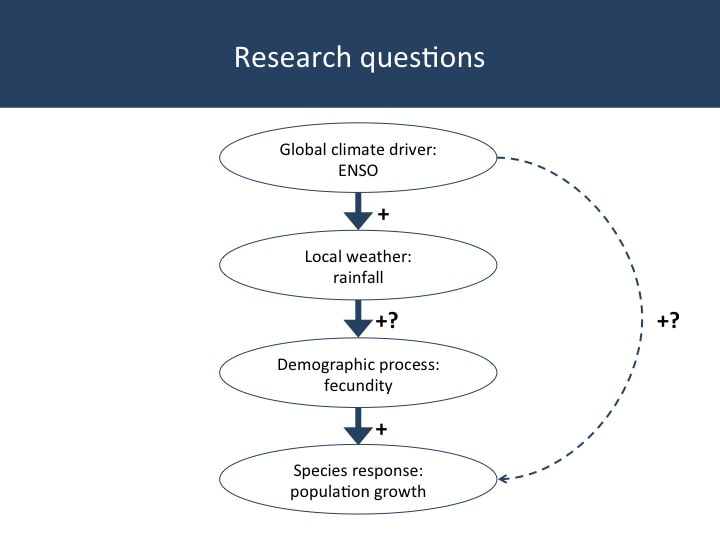climate change
global climate drivers of island population dynamics
|
Publications:
Hudgens, B., F. Beaudry, T.L. George, S. Kaiser, and N. Munkwitz. 2011. Shifting threats faced by the San Clemente sage sparrow (Amphispiza belli clementeae). Journal of Wildlife Management 75(6):1350-1360. Kaiser, S.A., E.L. Kershner, and D.K. Garcelon. 2009. The influence of nest substrate and nest site characteristics on the risk of San Clemente sage sparrow nest failure. Pages 301-313. In: Damiani, C.C and D.K. Garcelon, eds. Proceedings of the Seventh California Islands Symposium, Oxnard, California. Collaborators: Frederic Beaudry, Alfred University David Garcelon, Institute for Wildlife Studies T. Luke George, Humboldt State University Brian Hudgens, Institute for Wildlife Studies Eric Kershner, U.S. Fish & Wildlife Service |
Research Findings
Global climate cycles have been identified as important drivers of population and evolutionary dynamics. Predicting the responses of populations to environmental change requires an understanding of the links between global or regional climate patterns, local weather, demographic processes, and population dynamics. The El Niño Southern Oscillation (ENSO) is a well-studied global climate phenomena involving air exchange between the eastern and western hemispheres, and it is associated with fluctuations in the Pacific sea-surface temperature. Variation in ENSO has a strong nonlinear influence on winter rainfall in the southern California Channel Islands. Strong El Niño events are related to high rainfall in non-drought years, but the occurrence and severity of droughts are not associated with variation in ENSO. Winter rainfall, in turn, has a profound influence on the annual fecundity of Bell’s sparrows (Artemisiospiza belli clementeae). Birds largely forgo breeding during droughts, leading to population crashes. In wet years, nearly 100% of females are successful breeders, resulting in rapid population growth. Annual fecundity is therefore tied to rainfall in drought years but not wet years. Taken together, despite clear links between ENSO and rainfall, rainfall and fecundity, and fecundity and population dynamics, we found no predictable population response of Bell’s sparrows to variation in ENSO. The potential confounding effects of nonlinear processes indicate the importance of understanding the functional form of links between climate drivers and species responses.
©S.A. Kaiser 2012
